| Spiders
| Bats | Snakes
| Ants | Cockroaches
| Leeches | Rats
& Mice
Most spiders are small, inconspicuous
arthropods which are harmless to humans. Their beneficial role in keeping
insect populations in check far outweighs the hazard posed by the few spiders
that occasionally bite humans. Very few of the nearly 900 species of spiders
in Texas can hurt people. Only two groups--recluse spiders and widow spiders--
are considered poisonous to humans.
Tarantulas, jumping spiders,
wolf spiders and some other spiders worry people who mistakenly believe
they are seriously poisonous. Although these spiders are often large, hairy
and formidable-looking, their bite is typically less harmful than a bee
sting. People who are extremely allergic to spider venom, though, react
severely to any spider bite.
Many people have a phobia of
spiders. However, knowing how to distinguish harmless from dangerous spiders,
how to prevent them from entering the home and how to control those that
do enter can prevent needless concern and reduce the chances of harm to
humans.
Recluse
spiders
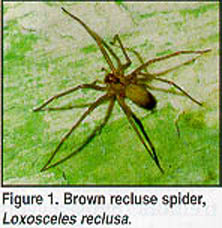 Five species of recluse spiders have been recorded in Texas: Loxosceles
apachae, L. blanda, L. devia, L. reclusa and L. rufescens. Although
only L. reclusa and L. rufescens have been recorded as venomous
to people, it is best to consider all these species as potentially dangerous.
Five species of recluse spiders have been recorded in Texas: Loxosceles
apachae, L. blanda, L. devia, L. reclusa and L. rufescens. Although
only L. reclusa and L. rufescens have been recorded as venomous
to people, it is best to consider all these species as potentially dangerous.
The best-known species, the
brown recluse spider, Loxosceles reclusa, inhabits many Southern
and Midwestern states. Recluse spiders are frequently found in garages,
firewood piles, cluttered cellars and stored board piles. They often live
around human dwellings, in bathrooms, bedrooms and closets, under furniture,
behind baseboards and door facings, or in corners and crevices. Recluse
spiders are most active at night when they hunt. People are sometimes bitten
while asleep, apparently when rolling over on a spider while in bed. Others
are bitten when putting on clothes that have hung undisturbed for a long
time and where spiders are hiding.
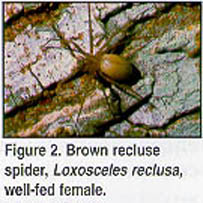
Description and life cycle
As their name implies, recluse
spiders are generally shy. They spin nondescript white or grayish webs,
where they may hide during the day. They are predators of insects and other
arthropods, known to wander around houses looking for prey. While walking,
their body and legs together cover an area about the size of a quarter
or half-dollar, but the body itself is only 1/4 to 1/2 inch long. Their
color varies from orange-yellow to dark brown.
The brown recluse?s most distinguishing
characteristics are its eye pattern and markings on the back. Recluse spiders
have six eyes arranged in three pairs in a semicircle on the forepart of
the head. Uncommon in spiders, this eye pattern helps separate recluse
spiders from similar species. The eyes also form the base of a violin-shaped
marking on the back. The neck of the ?violin? forms a distinct, short median
groove (see Figure 1). The violin marking may be conspicuous or blend with
the background color.
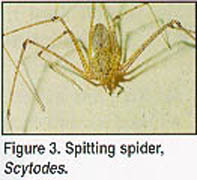 One other group of spiders, the spitting spiders, Scytodes, has
a similar eye arrangement. A spitting spider has long, spindly, banded
legs and a spotted pattern on its cephalothorax, the front body region.
The cephalothorax is raised in spitting spiders but nearly flat in recluse
spiders. Slow-moving, spitting spiders are common in window sills and considered
harmless.
One other group of spiders, the spitting spiders, Scytodes, has
a similar eye arrangement. A spitting spider has long, spindly, banded
legs and a spotted pattern on its cephalothorax, the front body region.
The cephalothorax is raised in spitting spiders but nearly flat in recluse
spiders. Slow-moving, spitting spiders are common in window sills and considered
harmless.
Brown recluse spiders lay one
to two egg masses per year in dark, sheltered areas. Similar to those of
many other spiders, recluse egg cases are round, about 5/8 inch (1.6 cm)
in diameter, flat on the bottom and convex on top. After 24 to 36 days,
an average of 50 spiderlings emerge from the egg case. Their slow development
is influenced greatly by nutrition and environmental conditions.
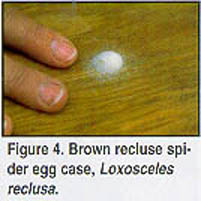
Bite symptoms
The effects of a recluse spider
bite may be immediate or delayed, depending on the amount of venom injected
and the victim?s sensitivity. Sometimes hardly noticed at first, the bite
later causes a stinging sensation that may include intense pain. Fever,
chills, nausea, weakness, restlessness and/or joint pain occur within 24
to 36 hours. The bite also produces a small blister surrounded by a large
congested and swollen area. The venom usually kills the affected tissue,
which gradually sloughs away and exposes underlying tissues. The edges
around the wound thicken, while the exposed center fills with dense scar
tissue. Healing may take six to eight weeks, often leaving a scar, depending
on the amount of venom injected and the reaction of the individual.
Widow
spiders
The southern black widow, Latrodectus
mactans, and its relatives live across the entire United States. Other
widow species found in Texas are the western black widow, L. hesperus;
the northern black widow, L. variolus; and probably the brown widow,
L.
geometricus. Their coloration varies considerably. For proper identification,
an expert may be needed to examine mature specimens.
Widow spiders are found in
protected cavities outdoors. Around houses, they may live in privies, garages,
cellars, furniture, shrubbery, ventilators, rain spouts, gas and electric
meters and other undisturbed places. Widow spiders also may be seen in
cotton fields and occasionally vegetable gardens.
Like most spiders, widow spiders
are shy and retiring. People are bitten occasionally when they accidentally
disturb a hidden spider or its web. To avoid hidden spiders, take care
when putting on seldom-worn shoes or clothing.
Description and life cycle
Widow spiders are typically
jet black, but their color can vary considerably. Males and juveniles tend
to show more color, with orange, red and white markings on the back and
sides. On the underside of their rounded abdomen are two reddish triangles
that may be united to form an hourglass shape.
Some individuals have irregular
or spot-like markings; others have none at all. Adult widow spiders average
11/2 inches long and have eight eyes in two rows, a common spider pattern.
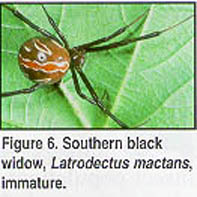
Females lay eggs in a loosely
woven cup of silk. The 1/2-inch-long oval egg sacs hold from 25 to 900
or more eggs, which incubate for about 20 days, depending on temperature
and time of year. Spiderlings usually stay near the egg sac for a few days
after they emerge, when cannibalism is prevalent. Surviving spiderlings
disperse by ?ballooning.? They spin a single silk thread which is caught
by the wind, which carries them to a new location. When about one-third
grown, they establish themselves in a protected place and build loosely
woven webs.
The spiders usually remain
in their rather coarse, irregular, tangled webs for the rest of their lives.
Over time they extend their webs and capture progressively larger prey.
Males eventually leave their webs to find females for mating. Contrary
to popular belief, most females do not normally eat the males after mating.
This habit, found in a few species of widow spiders from other areas, gives
the group its name.
Bite symptoms
If noticed at all, a widow
spider bite may feel like a pin prick. Usually the bite location is indicated
by a slight local swelling and two red spots surrounded by redness. The
reaction is systemic and pain becomes intense in one to three hours, continuing
for up to 48 hours. Symptoms include tremors, nausea, vomiting, leg cramps,
abdominal pain, profuse perspiration, loss of muscle tone and rise in blood
pressure. The toxin can also cause breathing difficulties and sometimes
unconsciousness. However, less than 5% of people bitten by widow spiders
die.
Other
common spiders
Tarantula
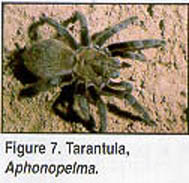 Tarantulas in Texas are members of the hairy mygalomorph family in the
genus Aphonopelma. These large, hairy spiders are brown to black
and more than 3 inches long when full-grown. Females, larger than males,
have abdomens about the size of a quarter.
Tarantulas in Texas are members of the hairy mygalomorph family in the
genus Aphonopelma. These large, hairy spiders are brown to black
and more than 3 inches long when full-grown. Females, larger than males,
have abdomens about the size of a quarter.
Tarantulas hunt at night and
spend the day under rocks, in abandoned mouse burrows or in other sheltered
areas. They may be seen in the evening or late at night along country roads
or trails. Migrating male tarantulas can be commonly seen for a few weeks
in early summer. This migration?s purpose is not completely understood,
but it may occur as males seek mates.
Tarantulas are sometimes kept
as pets and can become quite tame. Although they can be handled, be careful,
because they can quickly become disturbed and pierce the skin with their
fangs on the chelicerae. The hair on some tarantulas may irritate the skin,
so take care when handling them.
Tarantulas need a constant
supply of water in a flat dish into which they can lower their mouths.
They eat live crickets, mealworms, caterpillars or other insects and can
go for several weeks without food, sometimes refusing to eat before molting.
Tarantulas can crawl up glass and escape through small openings, so they
must be kept in a container with a good lid.
Jumping spiders
 Jumping spiders, all of which are in the family Salticidae, are among the
most interesting spider groups to watch. Jumping spiders come in many sizes
and color patterns. Active hunters during the day, they have good eyesight,
relying primarily on movement to locate prey. They stalk their prey before
attacking in a fast leap. Jumping spiders put out a line of webbing when
they jump and can sometimes be seen dangling from this silken dragline
after a leap that fails.
Jumping spiders, all of which are in the family Salticidae, are among the
most interesting spider groups to watch. Jumping spiders come in many sizes
and color patterns. Active hunters during the day, they have good eyesight,
relying primarily on movement to locate prey. They stalk their prey before
attacking in a fast leap. Jumping spiders put out a line of webbing when
they jump and can sometimes be seen dangling from this silken dragline
after a leap that fails.
Many jumping spiders are bold,
stocky and often brightly colored. They often have conspicuous bands of
black and white on their bodies or legs. Others have velvety red abdomens
and some even have metallic colors on the chelicerae. Jumping spiders have
eight eyes, with one large pair in the front. Like most spiders, jumping
spiders are not considered hazardous to humans and are unlikely to bite
unless cornered or handled.
The bold jumper, Phidippus
audax, is one of the most common and conspicuous of the jumping spiders.
It is black with a distinct irregular orange to white spot on the back
of the abdomen. It can be found in gardens and around homes.
Wolf spiders

Wolf spiders hunt at night.
Usually brown and black, they may have longitudinal stripes. Wolf spiders
are large and often seen under lights. They can be seen at night when their
eyes reflect light from a flashlight, headlamp or car headlight.
Members of the genera Rabidosa
and
Hogna
are
some of the most conspicuous wolf spiders. They form webbing only to provide
daytime shelter, not to capture prey. Many wolf spider females carry their
egg masses below their abdomens until after the eggs hatch. Young spiderlings
cling to the mother?s abdomen for a short time after hatching. Wolf spiders
frequently enter homes and backyards but pose no danger to people.
Orbweavers
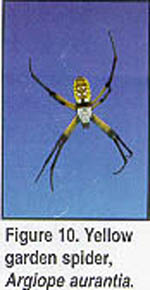
Orb-weaving spiders produce
the familiar flat, ornate, circular webs usually associated with spiders.
Orbweavers come in many shapes and sizes, but the brightly colored garden
orbweavers, Argiope, are the largest and best-known. The yellow
garden spider, Argiope aurantia, is marked with yellow, black, orange
or silver. The female body is more than 1 inch long with much longer legs.
It is also known as the black and yellow garden spider and sometimes the
writing spider because of a thickened interwoven section in the web?s center.
Male Argiope, often less than 1/4
the size of females, can sometimes
be found in the same web with the female. Garden orbweavers are so named
because their webs can be found in fields, on fences, around homes and
in other locations.
The spinybacked orbweaver,
Gasteracantha
cancriformis, is another distinctive orbweaver common in wooded areas.
The unusual flattened, spiny body shape makes it look like a crab. Abdomen
colors include white, yellow, orange or red.
Orbweavers are generally harmless
but can be a nuisance when they build large webs in places inconvenient
for humans.

Southern house spider
The southern house spider or
crevice spider, Kukulcania hibernalis, frequently enters homes and
causes concern when mistaken for a recluse spider. Southern house spider
females are larger and darker brown than males. Larger than recluse spiders,
they have eight eyes all in one cluster, and lack the recluse?s violin
marking. This spider?s distinctive web can be recognized by webbing radiating
outward from a central lair built in a hole or cavity. Southern house spiders
are common in old barns and undisturbed buildings.
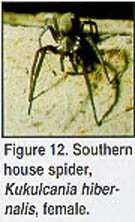
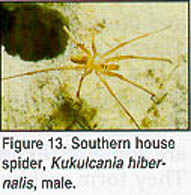
Controlling
spiders
? As a precautionary measure,
become familiar with what poisonous spiders look like and how they act.
? Because spiders nest in quiet,
undisturbed areas, discourage them by cleaning and vacuuming closets, cellars
and other such areas frequently.
? Seal buildings with caulk,
screening and weather stripping to keep spiders from entering.
? Tape or seal boxes, especially
in storage areas infested with brown recluse spiders.
? Where possible, wash off
outside areas, particularly under roof eaves, with a water hose.
? Mechanically removing the
webbing may be necessary because no chemical treatment to dissolve webs
is available.
? When chemical control is
needed, use products containing diazinon, chlorpyrifos, propoxur, bendiocarb,
synergized pyrethrins, carbaryl, resmethrin, tetramethrin, malathion or
mixtures of these insecticides. Always follow label directions and use
only products labeled for spider control or for use in areas where spiders
are found. Spray or dust outside under roof eaves, window ledges and porch
and patio roofs. Inside, spray around windows, door facings and baseboards
and in attics basements and storage places. Chemical control may not always
be as successful as desired because spiders are mobile and may migrate
back into the area. Also, species that sit on the web may not pick up much
residual pesticide.
? Because some spiders, such
as the brown recluse, can be difficult to control, homeowners may wish
to engage a professional pest control operator.
First
aid for spider bites
Relieve local swelling and pain
by applying an ice pack, ammonia or alcohol directly to the bite area.
In case of severe reaction, consult a doctor immediately and, if possible,
take along the spider for positive identification. Specific antivenin is
available to treat some widow spider bites.
Tips
for professionals
? Advanced-generation pyrethroids,
such as cyfluthrin, deltamethrin, lambda-cyhalothrin, tralomethrin and
bifenthrin, generally work well against spiders.
? Wettable powder formulations
generally provide superior residual control on wood, concrete and brick
surfaces.
? Residual pyrethroid dusts
such as cyfluthrin or deltamethrin provide excellent control in inaccessible
void areas.
? Brown recluse infestations
are best treated with a combination of sanitation, residual sprays and
dusts in appropriate areas.
? Aerosol fogs are generally
ineffective for all but exposed stages of spiders, but may provide a useful
supplement to residual sprays and dusts.
Produced by Agricultural Communications,
The Texas A&M University System
|
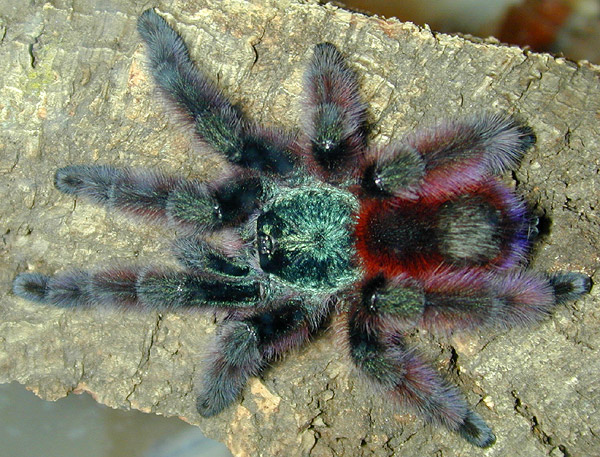
 Five species of recluse spiders have been recorded in Texas: Loxosceles
apachae, L. blanda, L. devia, L. reclusa and L. rufescens. Although
only L. reclusa and L. rufescens have been recorded as venomous
to people, it is best to consider all these species as potentially dangerous.
Five species of recluse spiders have been recorded in Texas: Loxosceles
apachae, L. blanda, L. devia, L. reclusa and L. rufescens. Although
only L. reclusa and L. rufescens have been recorded as venomous
to people, it is best to consider all these species as potentially dangerous.
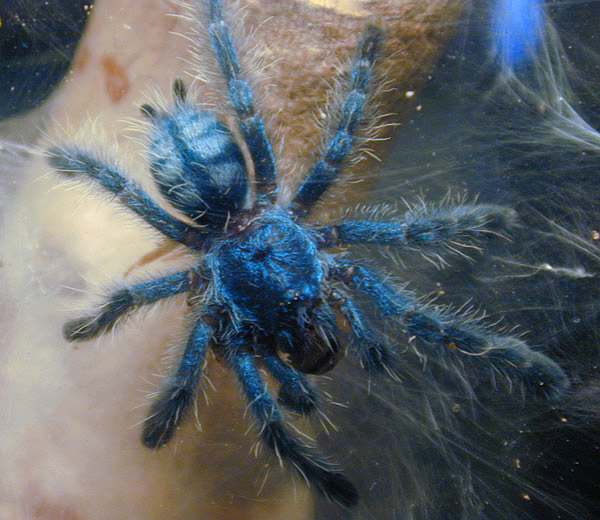

 One other group of spiders, the spitting spiders, Scytodes, has
a similar eye arrangement. A spitting spider has long, spindly, banded
legs and a spotted pattern on its cephalothorax, the front body region.
The cephalothorax is raised in spitting spiders but nearly flat in recluse
spiders. Slow-moving, spitting spiders are common in window sills and considered
harmless.
One other group of spiders, the spitting spiders, Scytodes, has
a similar eye arrangement. A spitting spider has long, spindly, banded
legs and a spotted pattern on its cephalothorax, the front body region.
The cephalothorax is raised in spitting spiders but nearly flat in recluse
spiders. Slow-moving, spitting spiders are common in window sills and considered
harmless.



 Tarantulas in Texas are members of the hairy mygalomorph family in the
genus Aphonopelma. These large, hairy spiders are brown to black
and more than 3 inches long when full-grown. Females, larger than males,
have abdomens about the size of a quarter.
Tarantulas in Texas are members of the hairy mygalomorph family in the
genus Aphonopelma. These large, hairy spiders are brown to black
and more than 3 inches long when full-grown. Females, larger than males,
have abdomens about the size of a quarter.
 Jumping spiders, all of which are in the family Salticidae, are among the
most interesting spider groups to watch. Jumping spiders come in many sizes
and color patterns. Active hunters during the day, they have good eyesight,
relying primarily on movement to locate prey. They stalk their prey before
attacking in a fast leap. Jumping spiders put out a line of webbing when
they jump and can sometimes be seen dangling from this silken dragline
after a leap that fails.
Jumping spiders, all of which are in the family Salticidae, are among the
most interesting spider groups to watch. Jumping spiders come in many sizes
and color patterns. Active hunters during the day, they have good eyesight,
relying primarily on movement to locate prey. They stalk their prey before
attacking in a fast leap. Jumping spiders put out a line of webbing when
they jump and can sometimes be seen dangling from this silken dragline
after a leap that fails.




